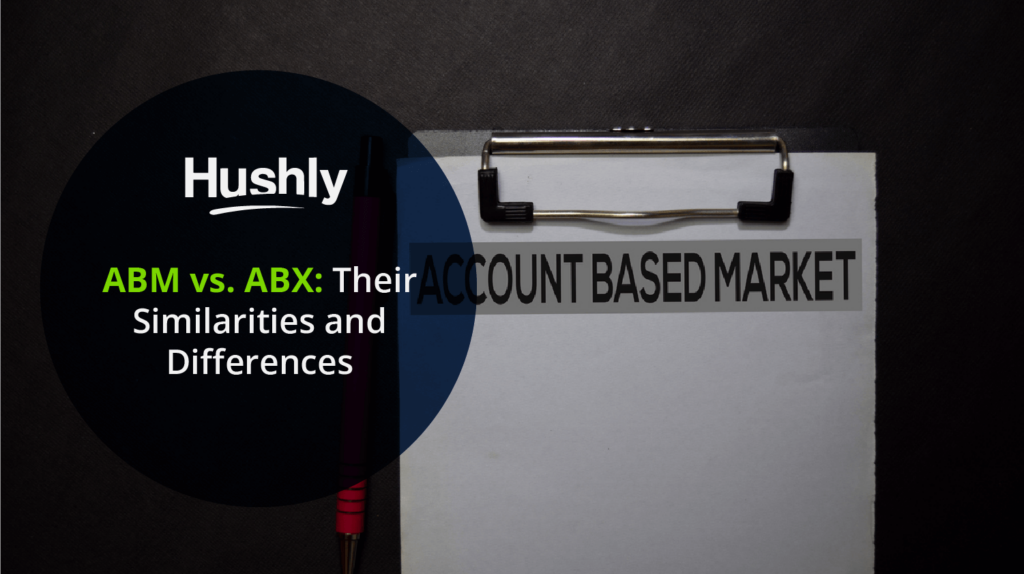Filters
Content Type
Topic
ABM vs. ABX: Their Similarities and Differences
Account-based marketing and experience, or ABM and ABX respectively, are marketing terms that describe a strategy aimed at targeting and impressing specific, high-quality B2B consumers. This is in contrast to a traditional marketing strategy, which might make a generic pitch to a general audience within an industry.
ABM originated in the early 1990s and became a widespread marketing tactic by the mid-2000s, led by marketing research firms like ITSMA. ABX is a term that originated in the last five years or so and describes a strategy that employs the same level of targeting as ABM but applies it to sales and customer service as well.
Today’s blog will describe what ABM and ABX have in common and where they ultimately diverge. We hope this will serve as a useful introduction to the topic so you can begin using its principles in your own daily strategies.

What is ABM?
Account-based marketing is an idea that originated in 1993 and developed steam in the early 2000s. After the mid-2000s, ABM was a well-accepted and widely adopted way to market B2B products.
Companies employing ABM strategies cater their messaging to specific businesses or buyers. As technology evolved, this practice went from specific marketing meetings with companies to tailored marketing content, phone calls, emails, and eventually features like microsites like the ones Hushly creates for clients.
ABM Puts Quality Over Quantity
The ABM approach seems simple, but it has powerful implications. When a business tailors marketing to specific B2B clients, it is also forced to ask the question of who those clients are and what their specific needs and wants are. These kinds of inquiries can lead to new product ideas, better customer relationships, and a more efficient marketing strategy overall.
ABM is a proven strategy and one with decades of testing to back it up. But there is a common problem with it that many companies have had to work to overcome – one that ABX is a direct response to.
ABM Can Create Expectation Dissonance
Experiencing a drop-off in service level and customer engagement after purchasing a product is a common way to create negative feelings on the part of your buyer.
A B2B buyer may feel that you put on a great face on the marketing front but aren’t able to match that level of competency in your sales and service. This may negatively affect the image of your company and make it less likely to attract the buyer to reorder when the time comes. It will also make it more difficult to market new products to them in the future, as they may not trust your non-marketing operations as much.
The conclusion is not that ABM is ineffective, but that sales and service departments need a similar strategy shift to facilitate and deliver on the gains marketing teams are making.
What is ABX?
The next evolution of ABM is ABX, which synthesizes the concepts of ABM into an end-to-end experience cycle that synchronizes sales, marketing, and service into one plan. This plan is focused on the titular buyer experience, which, of course, doesn’t end just because the sale was finalized.
Post-sale, an important buyer needs to keep feeling a unique and targeted experience with a similar level of engagement and access as when they were being sold on the product.
ABX techniques aim for a smooth transition between all phases of the buying cycle. Coordination is handled via a top-down account management structure, which typically involves widely authorized client liaisons that keep departments communicating well and functioning properly.
ABX does require a lot of information to implement correctly, so whoever is in charge of your most important accounts needs to be someone familiar with every aspect of your business and the clients.
ABX can also represent a shift in the culture of your business. Instead of separate arms of a company working in the dark towards a higher goal, the concrete path to great customer experience is laid out clearly.
The ABX Cycle
Great marketing leads to quality sales that need to be managed by consistent, best-in-class customer service. The revolutionary idea of ABX is to recognize that every interaction with a client is an opportunity to convince them they made the right choice with their purchase.
This top-down dedication to impressing the client every time is a form of marketing in and of itself. This makes the client much more likely to reorder and even rely on your company for future products.
Keeping the cycle synchronized and consistently high-quality is the ultimate challenge when implementing ABX at your company. As mentioned before, it’s also what creates the most difficult obstacles on the path to consistently great buyer experiences.
ABX Is Challenging But Rewarding
Because ABX can represent a big shift in responsibilities, roles, accountability, and even reporting structure, it is usually a major reorganization task that can leave loopholes and invisible cracks in some unexpected places.
While marketing can be approved and finalized well before a client ever sees it, problems and customer service scenarios happen on the fly and can’t always be predicted.
ABX challenges your company to handle even the most unpredictable situations consistently and smoothly every time without sacrificing messaging or allowing your departments to get out of sync.
Similarities and Differences Between ABM and ABX
Generally speaking, ABM is the predecessor to ABX and will be a smaller piece of a comprehensive ABX strategy. However, though they are based on the same ideas, ABM and ABX are two distinct concepts. A company can employ an ABM strategy without employing ABX or might use an account-based sales and service approach without similar marketing.
How ABM and ABX Are Similar
- Account Based: The AB in both nicknames is the core idea behind both ABM and ABX. Targeted, unique, high-quality, and consistent account-based B2B contact leads to better conversions and happier customers.
- Customer Focused: Valuing your customer relationships highly and managing them with that in mind is what drives ABM and ABX.
- Focused on Quality Conversions: Your biggest and best customers should receive the bulk of your company’s resources and attention.
Why ABM and ABX Are Different
- Different Purposes: ABM is concerned only with marketing, not with sales or service. For this reason, it would be inaccurate to say that ABX is replacing ABM. If anything, it is the next stage in its evolution.
- ABX is Less Tested: Though the ideas are thoroughly understood, the best ABX strategies are still being uncovered and tested.
- ABX is More Challenging: Marketing can be tested internally and vetted before being shown to clients. ABX requires your company to respond to obstacles in real time and tests your business’s ability to keep B2B buyers happy.
The Future of ABM and ABX
Marketing professionals who specialize in B2B strategies should find some way to begin implementing ABX at their company.
ABM is well understood, tested, and here to stay. ABX is just getting started. As technology makes the facilitation of this strategy easier and more efficient, it will only be a matter of time before it becomes the norm in B2B business transactions.
Just like a great online ordering interface and friendly, easy-to-reach customer service are necessities to grow your business, ABX will be a necessity to keep your biggest customers happy.
Request a personalized demo showing what the Hushly platform could do for your ABM and ABX strategies.
The post ABM vs. ABX: Their Similarities and Differences appeared first on Hushly.



